| Listing 1 - 10 of 15 | << page >> |
Sort by
|
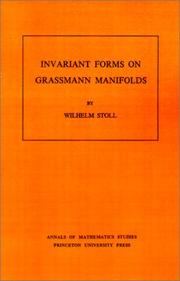
ISBN: 0691081980 0691081999 1400881889 9780691081991 9780691081984 Year: 1977 Volume: 89 Publisher: Princeton : Tokyo : Princeton University Press University of Tokyo press,
Abstract | Keywords | Export | Availability | Bookmark
 Loading...
Loading...Choose an application
- Reference Manager
- EndNote
- RefWorks (Direct export to RefWorks)
This work offers a contribution in the geometric form of the theory of several complex variables. Since complex Grassmann manifolds serve as classifying spaces of complex vector bundles, the cohomology structure of a complex Grassmann manifold is of importance for the construction of Chern classes of complex vector bundles. The cohomology ring of a Grassmannian is therefore of interest in topology, differential geometry, algebraic geometry, and complex analysis. Wilhelm Stoll treats certain aspects of the complex analysis point of view.This work originated with questions in value distribution theory. Here analytic sets and differential forms rather than the corresponding homology and cohomology classes are considered. On the Grassmann manifold, the cohomology ring is isomorphic to the ring of differential forms invariant under the unitary group, and each cohomology class is determined by a family of analytic sets.
Algebraic geometry --- Differential geometry. Global analysis --- Grassmann manifolds --- Differential forms. --- Grassmann manifolds. --- Invariants. --- Geometry, Differential. --- Géométrie différentielle. --- Differential invariants. --- Invariants différentiels. --- Forms, Differential --- Continuous groups --- Geometry, Differential --- Grassmannians --- Differential topology --- Manifolds (Mathematics) --- Calculation. --- Cohomology ring. --- Cohomology. --- Complex space. --- Cotangent bundle. --- Diagram (category theory). --- Exterior algebra. --- Grassmannian. --- Holomorphic vector bundle. --- Manifold. --- Regular map (graph theory). --- Remainder. --- Representation theorem. --- Schubert variety. --- Sesquilinear form. --- Theorem. --- Vector bundle. --- Vector space.
Book
ISBN: 140088232X Year: 2016 Publisher: Princeton, NJ : Princeton University Press,
Abstract | Keywords | Export | Availability | Bookmark
 Loading...
Loading...Choose an application
- Reference Manager
- EndNote
- RefWorks (Direct export to RefWorks)
The description for this book, Surface Area. (AM-35), Volume 35, will be forthcoming.
Surfaces. --- Absolute continuity. --- Addition. --- Admissible set. --- Arc length. --- Axiom. --- Axiomatic system. --- Bearing (navigation). --- Bounded variation. --- Calculus of variations. --- Circumference. --- Compact space. --- Complex analysis. --- Concentric. --- Connected space. --- Continuous function (set theory). --- Continuous function. --- Corollary. --- Countable set. --- Covering set. --- Curve. --- Derivative. --- Diameter. --- Differentiable function. --- Differential geometry. --- Direct proof. --- Dirichlet integral. --- Disjoint sets. --- Empty set. --- Equation. --- Equicontinuity. --- Existence theorem. --- Existential quantification. --- Function (mathematics). --- Functional analysis. --- Geometry. --- Hausdorff measure. --- Homeomorphism. --- Homotopy. --- Infimum and supremum. --- Integral geometry. --- Intersection number (graph theory). --- Interval (mathematics). --- Iterative method. --- Jacobian. --- Lebesgue integration. --- Lebesgue measure. --- Limit (mathematics). --- Limit point. --- Limit superior and limit inferior. --- Linearity. --- Line–line intersection. --- Locally compact space. --- Mathematician. --- Mathematics. --- Measure (mathematics). --- Metric space. --- Morphism. --- Natural number. --- Nonparametric statistics. --- Orientability. --- Parameter. --- Parametric equation. --- Parametric surface. --- Partial derivative. --- Potential theory. --- Radon–Nikodym theorem. --- Representation theorem. --- Representation theory. --- Right angle. --- Semi-continuity. --- Set function. --- Set theory. --- Sign (mathematics). --- Smoothness. --- Space-filling curve. --- Subset. --- Summation. --- Surface area. --- Tangent space. --- Theorem. --- Topological space. --- Topology. --- Total order. --- Total variation. --- Uniform convergence. --- Unit square.

ISBN: 0691081794 0691081840 1400881560 9780691081793 Year: 1976 Volume: no. 87 Publisher: Princeton : Princeton University Press,
Abstract | Keywords | Export | Availability | Bookmark
 Loading...
Loading...Choose an application
- Reference Manager
- EndNote
- RefWorks (Direct export to RefWorks)
The application by Fadeev and Pavlov of the Lax-Phillips scattering theory to the automorphic wave equation led Professors Lax and Phillips to reexamine this development within the framework of their theory. This volume sets forth the results of that work in the form of new or more straightforward treatments of the spectral theory of the Laplace-Beltrami operator over fundamental domains of finite area; the meromorphic character over the whole complex plane of the Eisenstein series; and the Selberg trace formula.CONTENTS: 1. Introduction. 2. An abstract scattering theory. 3. A modified theory for second order equations with an indefinite energy form. 4. The Laplace-Beltrami operator for the modular group. 5. The automorphic wave equation. 6. Incoming and outgoing subspaces for the automorphic wave equations. 7. The scattering matrix for the automorphic wave equation. 8. The general case. 9. The Selberg trace formula.
Harmonic analysis. Fourier analysis --- Automorphic functions --- Scattering (Mathematics) --- Fonctions automorphes --- Dispersion (Mathématiques) --- Automorphic functions. --- Scattering (Mathematics). --- Dispersion (Mathématiques) --- Selberg, Formule de trace de --- Selberg trace formula --- Eisenstein series --- Eisenstein, Séries d' --- Scattering theory (Mathematics) --- Boundary value problems --- Differential equations, Partial --- Scattering operator --- Fuchsian functions --- Functions, Automorphic --- Functions, Fuchsian --- Functions of several complex variables --- Absolute continuity. --- Algebra. --- Analytic continuation. --- Analytic function. --- Annulus (mathematics). --- Asymptotic distribution. --- Automorphic function. --- Bilinear form. --- Boundary (topology). --- Boundary value problem. --- Bounded operator. --- Calculation. --- Cauchy sequence. --- Change of variables. --- Complex plane. --- Conjugacy class. --- Convolution. --- Cusp neighborhood. --- Cyclic group. --- Derivative. --- Differential equation. --- Differential operator. --- Dimension (vector space). --- Dimensional analysis. --- Dirichlet integral. --- Dirichlet series. --- Eigenfunction. --- Eigenvalues and eigenvectors. --- Eisenstein series. --- Elliptic operator. --- Elliptic partial differential equation. --- Equation. --- Equivalence class. --- Even and odd functions. --- Existential quantification. --- Explicit formula. --- Explicit formulae (L-function). --- Exponential function. --- Fourier transform. --- Function space. --- Functional analysis. --- Functional calculus. --- Fundamental domain. --- Harmonic analysis. --- Hilbert space. --- Hyperbolic partial differential equation. --- Infinitesimal generator (stochastic processes). --- Integral equation. --- Integration by parts. --- Invariant subspace. --- Laplace operator. --- Laplace transform. --- Lebesgue measure. --- Linear differential equation. --- Linear space (geometry). --- Matrix (mathematics). --- Maximum principle. --- Meromorphic function. --- Modular group. --- Neumann boundary condition. --- Norm (mathematics). --- Null vector. --- Number theory. --- Operator theory. --- Orthogonal complement. --- Orthonormal basis. --- Paley–Wiener theorem. --- Partial differential equation. --- Perturbation theory (quantum mechanics). --- Perturbation theory. --- Primitive element (finite field). --- Principal component analysis. --- Projection (linear algebra). --- Quadratic form. --- Removable singularity. --- Representation theorem. --- Resolvent set. --- Riemann hypothesis. --- Riemann surface. --- Riemann zeta function. --- Riesz representation theorem. --- Scatter matrix. --- Scattering theory. --- Schwarz reflection principle. --- Selberg trace formula. --- Self-adjoint. --- Semigroup. --- Sign (mathematics). --- Spectral theory. --- Subgroup. --- Subsequence. --- Summation. --- Support (mathematics). --- Theorem. --- Trace class. --- Trace formula. --- Unitary operator. --- Wave equation. --- Weighted arithmetic mean. --- Winding number. --- Eisenstein, Séries d'. --- Analyse harmonique
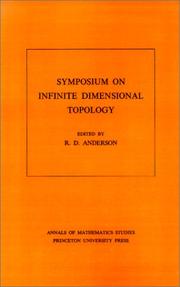
ISBN: 0691080879 1400881404 9780691080871 Year: 1972 Volume: 69 Publisher: Princeton : Princeton University Press,
Abstract | Keywords | Export | Availability | Bookmark
 Loading...
Loading...Choose an application
- Reference Manager
- EndNote
- RefWorks (Direct export to RefWorks)
In essence the proceedings of the 1967 meeting in Baton Rouge, the volume offers significant papers in the topology of infinite dimensional linear spaces, fixed point theory in infinite dimensional spaces, infinite dimensional differential topology, and infinite dimensional pointset topology. Later results of the contributors underscore the basic soundness of this selection, which includes survey and expository papers, as well as reports of continuing research.
Topology --- Differential geometry. Global analysis --- Differential topology --- Functional analysis --- Congresses --- Analyse fonctionnnelle --- Geometry, Differential --- Anderson's theorem. --- Annihilator (ring theory). --- Automorphism. --- Baire measure. --- Banach algebra. --- Banach manifold. --- Banach space. --- Bounded operator. --- Cartesian product. --- Characterization (mathematics). --- Cohomology. --- Compact space. --- Complement (set theory). --- Complete metric space. --- Connected space. --- Continuous function. --- Convex set. --- Coset. --- Critical point (mathematics). --- Diagram (category theory). --- Differentiable manifold. --- Differential topology. --- Dimension (vector space). --- Dimension. --- Dimensional analysis. --- Dual space. --- Duality (mathematics). --- Endomorphism. --- Equivalence class. --- Euclidean space. --- Existential quantification. --- Explicit formulae (L-function). --- Exponential map (Riemannian geometry). --- Fixed-point theorem. --- Fréchet derivative. --- Fréchet space. --- Fuchsian group. --- Function space. --- Fundamental class. --- Haar measure. --- Hessian matrix. --- Hilbert space. --- Homeomorphism. --- Homology (mathematics). --- Homotopy group. --- Homotopy. --- Inclusion map. --- Infimum and supremum. --- Lebesgue space. --- Lefschetz fixed-point theorem. --- Limit point. --- Linear space (geometry). --- Locally convex topological vector space. --- Loop space. --- Mathematical optimization. --- Measure (mathematics). --- Metric space. --- Module (mathematics). --- Natural topology. --- Neighbourhood (mathematics). --- Normal space. --- Normed vector space. --- Open set. --- Ordinal number. --- Paracompact space. --- Partition of unity. --- Path space. --- Product topology. --- Quantifier (logic). --- Quotient space (linear algebra). --- Quotient space (topology). --- Radon measure. --- Reflexive space. --- Representation theorem. --- Riemannian manifold. --- Schauder fixed point theorem. --- Sign (mathematics). --- Simply connected space. --- Space form. --- Special case. --- Stiefel manifold. --- Strong operator topology. --- Subcategory. --- Submanifold. --- Subset. --- Tangent space. --- Teichmüller space. --- Theorem. --- Topological space. --- Topological vector space. --- Topology. --- Transfinite induction. --- Transfinite. --- Transversal (geometry). --- Transversality theorem. --- Tychonoff cube. --- Union (set theory). --- Unit sphere. --- Weak topology. --- Weakly compact. --- Differential topology - Congresses --- Functional analysis - Congresses --- Topology - Congresses
Book
ISBN: 0691079994 1400881986 9780691079998 Year: 2016 Volume: 38 Publisher: Princeton, NJ : Princeton University Press,
Abstract | Keywords | Export | Availability | Bookmark
 Loading...
Loading...Choose an application
- Reference Manager
- EndNote
- RefWorks (Direct export to RefWorks)
The description for this book, Linear Inequalities and Related Systems. (AM-38), Volume 38, will be forthcoming.
Operational research. Game theory --- Linear programming. --- Matrices. --- Game theory. --- Games, Theory of --- Theory of games --- Mathematical models --- Mathematics --- Algebra, Matrix --- Cracovians (Mathematics) --- Matrix algebra --- Matrixes (Algebra) --- Algebra, Abstract --- Algebra, Universal --- Production scheduling --- Programming (Mathematics) --- Banach space. --- Basic solution (linear programming). --- Big O notation. --- Bilinear form. --- Boundary (topology). --- Brouwer fixed-point theorem. --- Characterization (mathematics). --- Coefficient. --- Combination. --- Computation. --- Computational problem. --- Convex combination. --- Convex cone. --- Convex hull. --- Convex set. --- Corollary. --- Correlation and dependence. --- Cramer's rule. --- Cyclic permutation. --- Dedekind cut. --- Degeneracy (mathematics). --- Determinant. --- Diagram (category theory). --- Dilworth's theorem. --- Dimension (vector space). --- Directional derivative. --- Disjoint sets. --- Doubly stochastic matrix. --- Dual space. --- Duality (mathematics). --- Duality (optimization). --- Eigenvalues and eigenvectors. --- Elementary proof. --- Equation solving. --- Equation. --- Equivalence class. --- Euclidean space. --- Existence theorem. --- Existential quantification. --- Extreme point. --- Fixed-point theorem. --- Functional analysis. --- Fundamental theorem. --- General equilibrium theory. --- Hall's theorem. --- Hilbert space. --- Incidence matrix. --- Inequality (mathematics). --- Infimum and supremum. --- Invertible matrix. --- Kakutani fixed-point theorem. --- Lagrange multiplier. --- Linear equation. --- Linear inequality. --- Linear map. --- Linear space (geometry). --- Linear subspace. --- Loss function. --- Main diagonal. --- Mathematical induction. --- Mathematical optimization. --- Mathematical problem. --- Max-flow min-cut theorem. --- Maxima and minima. --- Maximal set. --- Maximum flow problem. --- Menger's theorem. --- Minor (linear algebra). --- Monotonic function. --- N-vector. --- Nonlinear programming. --- Nonnegative matrix. --- Parity (mathematics). --- Partially ordered set. --- Permutation matrix. --- Permutation. --- Polyhedron. --- Quantity. --- Representation theorem. --- Row and column vectors. --- Scientific notation. --- Sensitivity analysis. --- Set notation. --- Sign (mathematics). --- Simplex algorithm. --- Simultaneous equations. --- Solution set. --- Special case. --- Subset. --- Summation. --- System of linear equations. --- Theorem. --- Transpose. --- Unit sphere. --- Unit vector. --- Upper and lower bounds. --- Variable (mathematics). --- Vector space. --- Von Neumann's theorem.
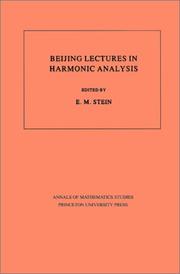
ISBN: 0691084181 069108419X 1400882095 Year: 2016 Publisher: Princeton, NJ : Princeton University Press,
Abstract | Keywords | Export | Availability | Bookmark
 Loading...
Loading...Choose an application
- Reference Manager
- EndNote
- RefWorks (Direct export to RefWorks)
Based on seven lecture series given by leading experts at a summer school at Peking University, in Beijing, in 1984. this book surveys recent developments in the areas of harmonic analysis most closely related to the theory of singular integrals, real-variable methods, and applications to several complex variables and partial differential equations. The different lecture series are closely interrelated; each contains a substantial amount of background material, as well as new results not previously published. The contributors to the volume are R. R. Coifman and Yves Meyer, Robert Fcfferman,Carlos K. Kenig, Steven G. Krantz, Alexander Nagel, E. M. Stein, and Stephen Wainger.
Harmonic analysis. --- Analysis (Mathematics) --- Functions, Potential --- Potential functions --- Banach algebras --- Calculus --- Mathematical analysis --- Mathematics --- Bessel functions --- Fourier series --- Harmonic functions --- Time-series analysis --- Analytic function. --- Asymptotic formula. --- Bergman metric. --- Bernhard Riemann. --- Bessel function. --- Biholomorphism. --- Boundary value problem. --- Bounded mean oscillation. --- Bounded operator. --- Boundedness. --- Cauchy's integral formula. --- Characteristic function (probability theory). --- Characterization (mathematics). --- Coefficient. --- Commutator. --- Complexification (Lie group). --- Continuous function. --- Convolution. --- Degeneracy (mathematics). --- Differential equation. --- Differential operator. --- Dirac delta function. --- Dirichlet problem. --- Equation. --- Estimation. --- Existence theorem. --- Existential quantification. --- Explicit formula. --- Explicit formulae (L-function). --- Fatou's theorem. --- Fourier analysis. --- Fourier integral operator. --- Fourier transform. --- Fredholm theory. --- Fubini's theorem. --- Function (mathematics). --- Functional calculus. --- Fundamental solution. --- Gaussian curvature. --- Hardy space. --- Harmonic function. --- Harmonic measure. --- Heisenberg group. --- Hilbert space. --- Hilbert transform. --- Hodge theory. --- Holomorphic function. --- Hyperbolic partial differential equation. --- Hölder's inequality. --- Infimum and supremum. --- Integration by parts. --- Interpolation theorem. --- Intersection (set theory). --- Invertible matrix. --- Isometry group. --- Laplace operator. --- Laplace's equation. --- Lebesgue measure. --- Linear map. --- Lipschitz continuity. --- Lipschitz domain. --- Lp space. --- Mathematical induction. --- Mathematical physics. --- Maximal function. --- Maximum principle. --- Measure (mathematics). --- Newtonian potential. --- Non-Euclidean geometry. --- Number theory. --- Operator theory. --- Oscillatory integral. --- Parameter. --- Partial derivative. --- Partial differential equation. --- Polynomial. --- Power series. --- Product metric. --- Radon–Nikodym theorem. --- Riemannian manifold. --- Riesz representation theorem. --- Scientific notation. --- Several complex variables. --- Sign (mathematics). --- Simultaneous equations. --- Singular function. --- Singular integral. --- Sobolev space. --- Square (algebra). --- Statistical hypothesis testing. --- Stokes' theorem. --- Support (mathematics). --- Tangent space. --- Tensor product. --- Theorem. --- Trigonometric series. --- Uniformization theorem. --- Variable (mathematics). --- Vector field.
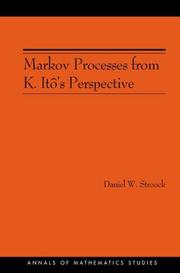
ISBN: 0691115427 1400835577 0691115435 1322063230 9781400835577 9781322063232 9780691115436 9870691115427 9780691115429 Year: 2003 Publisher: Princeton, New Jersey ; Oxfordshire, England : Princeton University Press,
Abstract | Keywords | Export | Availability | Bookmark
 Loading...
Loading...Choose an application
- Reference Manager
- EndNote
- RefWorks (Direct export to RefWorks)
Kiyosi Itô's greatest contribution to probability theory may be his introduction of stochastic differential equations to explain the Kolmogorov-Feller theory of Markov processes. Starting with the geometric ideas that guided him, this book gives an account of Itô's program. The modern theory of Markov processes was initiated by A. N. Kolmogorov. However, Kolmogorov's approach was too analytic to reveal the probabilistic foundations on which it rests. In particular, it hides the central role played by the simplest Markov processes: those with independent, identically distributed increments. To remedy this defect, Itô interpreted Kolmogorov's famous forward equation as an equation that describes the integral curve of a vector field on the space of probability measures. Thus, in order to show how Itô's thinking leads to his theory of stochastic integral equations, Stroock begins with an account of integral curves on the space of probability measures and then arrives at stochastic integral equations when he moves to a pathspace setting. In the first half of the book, everything is done in the context of general independent increment processes and without explicit use of Itô's stochastic integral calculus. In the second half, the author provides a systematic development of Itô's theory of stochastic integration: first for Brownian motion and then for continuous martingales. The final chapter presents Stratonovich's variation on Itô's theme and ends with an application to the characterization of the paths on which a diffusion is supported. The book should be accessible to readers who have mastered the essentials of modern probability theory and should provide such readers with a reasonably thorough introduction to continuous-time, stochastic processes.
Markov processes. --- Stochastic difference equations. --- Itō, Kiyosi, --- Analysis, Markov --- Chains, Markov --- Markoff processes --- Markov analysis --- Markov chains --- Markov models --- Models, Markov --- Processes, Markov --- Itō, K. --- Ito, Kiesi, --- Itō, Kiyoshi, --- 伊藤淸, --- 伊藤清, --- Itō, Kiyosi, --- Itō, Kiyosi, 1915-2008. --- Stochastic difference equations --- Difference equations --- Stochastic processes --- Abelian group. --- Addition. --- Analytic function. --- Approximation. --- Bernhard Riemann. --- Bounded variation. --- Brownian motion. --- Central limit theorem. --- Change of variables. --- Coefficient. --- Complete metric space. --- Compound Poisson process. --- Continuous function (set theory). --- Continuous function. --- Convergence of measures. --- Convex function. --- Coordinate system. --- Corollary. --- David Hilbert. --- Decomposition theorem. --- Degeneracy (mathematics). --- Derivative. --- Diffeomorphism. --- Differentiable function. --- Differentiable manifold. --- Differential equation. --- Differential geometry. --- Dimension. --- Directional derivative. --- Doob–Meyer decomposition theorem. --- Duality principle. --- Elliptic operator. --- Equation. --- Euclidean space. --- Existential quantification. --- Fourier transform. --- Function space. --- Functional analysis. --- Fundamental solution. --- Fundamental theorem of calculus. --- Homeomorphism. --- Hölder's inequality. --- Initial condition. --- Integral curve. --- Integral equation. --- Integration by parts. --- Invariant measure. --- Itô calculus. --- Itô's lemma. --- Joint probability distribution. --- Lebesgue measure. --- Linear interpolation. --- Lipschitz continuity. --- Local martingale. --- Logarithm. --- Markov chain. --- Markov process. --- Markov property. --- Martingale (probability theory). --- Normal distribution. --- Ordinary differential equation. --- Ornstein–Uhlenbeck process. --- Polynomial. --- Principal part. --- Probability measure. --- Probability space. --- Probability theory. --- Pseudo-differential operator. --- Radon–Nikodym theorem. --- Representation theorem. --- Riemann integral. --- Riemann sum. --- Riemann–Stieltjes integral. --- Scientific notation. --- Semimartingale. --- Sign (mathematics). --- Special case. --- Spectral sequence. --- Spectral theory. --- State space. --- State-space representation. --- Step function. --- Stochastic calculus. --- Stochastic. --- Stratonovich integral. --- Submanifold. --- Support (mathematics). --- Tangent space. --- Tangent vector. --- Taylor's theorem. --- Theorem. --- Theory. --- Topological space. --- Topology. --- Translational symmetry. --- Uniform convergence. --- Variable (mathematics). --- Vector field. --- Weak convergence (Hilbert space). --- Weak topology.

ISBN: 1282129740 9786612129742 1400827787 9781400827787 9781282129740 0691129185 9780691129181 6612129743 Year: 2007 Publisher: Princeton, N.J. : Princeton University Press,
Abstract | Keywords | Export | Availability | Bookmark
 Loading...
Loading...Choose an application
- Reference Manager
- EndNote
- RefWorks (Direct export to RefWorks)
This book represents the first synthesis of the considerable body of new research into positive definite matrices. These matrices play the same role in noncommutative analysis as positive real numbers do in classical analysis. They have theoretical and computational uses across a broad spectrum of disciplines, including calculus, electrical engineering, statistics, physics, numerical analysis, quantum information theory, and geometry. Through detailed explanations and an authoritative and inspiring writing style, Rajendra Bhatia carefully develops general techniques that have wide applications in the study of such matrices. Bhatia introduces several key topics in functional analysis, operator theory, harmonic analysis, and differential geometry--all built around the central theme of positive definite matrices. He discusses positive and completely positive linear maps, and presents major theorems with simple and direct proofs. He examines matrix means and their applications, and shows how to use positive definite functions to derive operator inequalities that he and others proved in recent years. He guides the reader through the differential geometry of the manifold of positive definite matrices, and explains recent work on the geometric mean of several matrices. Positive Definite Matrices is an informative and useful reference book for mathematicians and other researchers and practitioners. The numerous exercises and notes at the end of each chapter also make it the ideal textbook for graduate-level courses.
Matrices. --- Algebra, Matrix --- Cracovians (Mathematics) --- Matrix algebra --- Matrixes (Algebra) --- Algebra, Abstract --- Algebra, Universal --- Matrices --- 512.64 --- 512.64 Linear and multilinear algebra. Matrix theory --- Linear and multilinear algebra. Matrix theory --- Addition. --- Analytic continuation. --- Arithmetic mean. --- Banach space. --- Binomial theorem. --- Block matrix. --- Bochner's theorem. --- Calculation. --- Cauchy matrix. --- Cauchy–Schwarz inequality. --- Characteristic polynomial. --- Coefficient. --- Commutative property. --- Compact space. --- Completely positive map. --- Complex number. --- Computation. --- Continuous function. --- Convex combination. --- Convex function. --- Convex set. --- Corollary. --- Density matrix. --- Diagonal matrix. --- Differential geometry. --- Eigenvalues and eigenvectors. --- Equation. --- Equivalence relation. --- Existential quantification. --- Extreme point. --- Fourier transform. --- Functional analysis. --- Fundamental theorem. --- G. H. Hardy. --- Gamma function. --- Geometric mean. --- Geometry. --- Hadamard product (matrices). --- Hahn–Banach theorem. --- Harmonic analysis. --- Hermitian matrix. --- Hilbert space. --- Hyperbolic function. --- Infimum and supremum. --- Infinite divisibility (probability). --- Invertible matrix. --- Lecture. --- Linear algebra. --- Linear map. --- Logarithm. --- Logarithmic mean. --- Mathematics. --- Matrix (mathematics). --- Matrix analysis. --- Matrix unit. --- Metric space. --- Monotonic function. --- Natural number. --- Open set. --- Operator algebra. --- Operator system. --- Orthonormal basis. --- Partial trace. --- Positive definiteness. --- Positive element. --- Positive map. --- Positive semidefinite. --- Positive-definite function. --- Positive-definite matrix. --- Probability measure. --- Probability. --- Projection (linear algebra). --- Quantity. --- Quantum computing. --- Quantum information. --- Quantum statistical mechanics. --- Real number. --- Riccati equation. --- Riemannian geometry. --- Riemannian manifold. --- Riesz representation theorem. --- Right half-plane. --- Schur complement. --- Schur's theorem. --- Scientific notation. --- Self-adjoint operator. --- Sign (mathematics). --- Special case. --- Spectral theorem. --- Square root. --- Standard basis. --- Summation. --- Tensor product. --- Theorem. --- Toeplitz matrix. --- Unit vector. --- Unitary matrix. --- Unitary operator. --- Upper half-plane. --- Variable (mathematics).
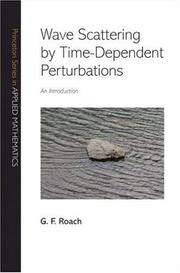
ISBN: 1282158783 9786612158780 1400828163 9781400828166 9781282158788 9780691113401 0691113408 6612158786 Year: 2007 Publisher: Princeton, N.J. : Princeton University Press,
Abstract | Keywords | Export | Availability | Bookmark
 Loading...
Loading...Choose an application
- Reference Manager
- EndNote
- RefWorks (Direct export to RefWorks)
This book offers the first comprehensive introduction to wave scattering in nonstationary materials. G. F. Roach's aim is to provide an accessible, self-contained resource for newcomers to this important field of research that has applications across a broad range of areas, including radar, sonar, diagnostics in engineering and manufacturing, geophysical prospecting, and ultrasonic medicine such as sonograms. New methods in recent years have been developed to assess the structure and properties of materials and surfaces. When light, sound, or some other wave energy is directed at the material in question, "imperfections" in the resulting echo can reveal a tremendous amount of valuable diagnostic information. The mathematics behind such analysis is sophisticated and complex. However, while problems involving stationary materials are quite well understood, there is still much to learn about those in which the material is moving or changes over time. These so-called non-autonomous problems are the subject of this fascinating book. Roach develops practical strategies, techniques, and solutions for mathematicians and applied scientists working in or seeking entry into the field of modern scattering theory and its applications. Wave Scattering by Time-Dependent Perturbations is destined to become a classic in this rapidly evolving area of inquiry.
Waves --- Scattering (Physics) --- Perturbation (Mathematics) --- Perturbation equations --- Perturbation theory --- Approximation theory --- Dynamics --- Functional analysis --- Mathematical physics --- Atomic scattering --- Atoms --- Nuclear scattering --- Particles (Nuclear physics) --- Scattering of particles --- Wave scattering --- Collisions (Nuclear physics) --- Particles --- Collisions (Physics) --- Cycles --- Hydrodynamics --- Benjamin-Feir instability --- Mathematics. --- Scattering --- Acoustic wave equation. --- Acoustic wave. --- Affine space. --- Angular frequency. --- Approximation. --- Asymptotic analysis. --- Asymptotic expansion. --- Banach space. --- Basis (linear algebra). --- Bessel's inequality. --- Boundary value problem. --- Bounded operator. --- C0-semigroup. --- Calculation. --- Characteristic function (probability theory). --- Classical physics. --- Codimension. --- Coefficient. --- Continuous function (set theory). --- Continuous function. --- Continuous spectrum. --- Convolution. --- Differentiable function. --- Differential equation. --- Dimension (vector space). --- Dimension. --- Dimensional analysis. --- Dirac delta function. --- Dirichlet problem. --- Distribution (mathematics). --- Duhamel's principle. --- Eigenfunction. --- Eigenvalues and eigenvectors. --- Electromagnetism. --- Equation. --- Existential quantification. --- Exponential function. --- Floquet theory. --- Fourier inversion theorem. --- Fourier series. --- Fourier transform. --- Fredholm integral equation. --- Frequency domain. --- Helmholtz equation. --- Hilbert space. --- Initial value problem. --- Integral equation. --- Integral transform. --- Integration by parts. --- Inverse problem. --- Inverse scattering problem. --- Lebesgue measure. --- Linear differential equation. --- Linear map. --- Linear space (geometry). --- Locally integrable function. --- Longitudinal wave. --- Mathematical analysis. --- Mathematical physics. --- Metric space. --- Operator theory. --- Ordinary differential equation. --- Orthonormal basis. --- Orthonormality. --- Parseval's theorem. --- Partial derivative. --- Partial differential equation. --- Phase velocity. --- Plane wave. --- Projection (linear algebra). --- Propagator. --- Quantity. --- Quantum mechanics. --- Reflection coefficient. --- Requirement. --- Riesz representation theorem. --- Scalar (physics). --- Scattering theory. --- Scattering. --- Scientific notation. --- Self-adjoint operator. --- Self-adjoint. --- Series expansion. --- Sine wave. --- Spectral method. --- Spectral theorem. --- Spectral theory. --- Square-integrable function. --- Subset. --- Theorem. --- Theory. --- Time domain. --- Time evolution. --- Unbounded operator. --- Unitarity (physics). --- Vector space. --- Volterra integral equation. --- Wave function. --- Wave packet. --- Wave propagation.
Book
ISBN: 0691653690 1400876451 Year: 2015 Publisher: Princeton, NJ : Princeton University Press,
Abstract | Keywords | Export | Availability | Bookmark
 Loading...
Loading...Choose an application
- Reference Manager
- EndNote
- RefWorks (Direct export to RefWorks)
Book 6 in the Princeton Mathematical Series.Originally published in 1941.The Princeton Legacy Library uses the latest print-on-demand technology to again make available previously out-of-print books from the distinguished backlist of Princeton University Press. These editions preserve the original texts of these important books while presenting them in durable paperback and hardcover editions. The goal of the Princeton Legacy Library is to vastly increase access to the rich scholarly heritage found in the thousands of books published by Princeton University Press since its founding in 1905.
Laplace transformation. --- Absolute continuity. --- Absolute convergence. --- Absolute value. --- Analytic continuation. --- Analytic function. --- Antiderivative. --- Arbitrarily large. --- Arithmetic progression. --- Asymptote. --- Auxiliary function. --- Bernstein polynomial. --- Bessel function. --- Big O notation. --- Bounded function. --- Bounded variation. --- Cauchy's theorem (group theory). --- Central limit theorem. --- Change of variables. --- Complex number. --- Conjugate transpose. --- Continuous function (set theory). --- Continuous function. --- Countable set. --- Derivative. --- Determinant. --- Differential operator. --- Dirichlet integral. --- Dirichlet series. --- Entire function. --- Equation. --- Euler's theorem. --- Existential quantification. --- Finite difference. --- Fubini's theorem. --- Function (mathematics). --- Generating function. --- Hamburger moment problem. --- Hausdorff moment problem. --- Helly–Bray theorem. --- Hölder's inequality. --- Imaginary number. --- Improper integral. --- Infimum and supremum. --- Integral equation. --- Integration by parts. --- Laguerre polynomials. --- Lambert series. --- Laplace transform. --- Laurent series. --- Lebesgue integration. --- Lebesgue–Stieltjes integration. --- Leibniz integral rule. --- Limit of a sequence. --- Limit point. --- Limit superior and limit inferior. --- Lipschitz continuity. --- Mathematical induction. --- Mean value theorem. --- Moment problem. --- Monotonic function. --- Multiple integral. --- Natural number. --- Order condition. --- Order of integration (calculus). --- Order of integration. --- Parseval's theorem. --- Plancherel theorem. --- Polynomial. --- Positive polynomial. --- Positive semidefinite. --- Power series. --- Prime factor. --- Prime number theorem. --- Prime number. --- Principal value. --- Radius of convergence. --- Representation theorem. --- Resultant. --- Riemann–Stieltjes integral. --- Right half-plane. --- Series (mathematics). --- Series expansion. --- Sign (mathematics). --- Simultaneous equations. --- Singular integral. --- Special case. --- Stieltjes moment problem. --- Stone–Weierstrass theorem. --- Summation. --- Taylor's theorem. --- Theorem. --- Total variation. --- Uniform continuity. --- Uniform convergence. --- Uniqueness theorem. --- Upper and lower bounds. --- Vanish at infinity. --- Variable (mathematics). --- Without loss of generality. --- Zero of a function.
| Listing 1 - 10 of 15 | << page >> |
Sort by
|

 Search
Search Feedback
Feedback About
About Help
Help News
News